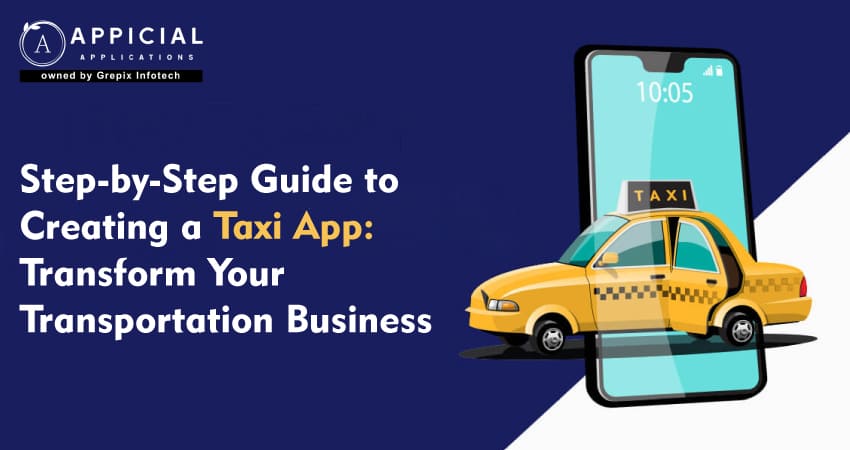
Step-by-Step Guide to Creating a Taxi App: Transform Your Transportation Business
In today's fast-paced world, the transportation industry is experiencing a revolutionary shift, largely driven by the advancements in mobile technology. Taxi apps have emerged as a game-changer, providing users with seamless, efficient, and safe transportation solutions at their fingertips. For transportation businesses, developing a taxi app is not just a trend but a strategic move to stay competitive and meet the growing demands of modern commuters.
Creating a taxi app involves a blend of innovative thinking, meticulous planning, and technical expertise. This step-by-step guide is designed to take you through the entire process, from initial concept to launch and beyond. Whether you're a startup looking to make a mark or an established business aiming to expand your services, this guide will provide you with the insights and tools needed to develop a successful taxi app. Embrace this opportunity to transform your transportation business and stay ahead in the digital age.
Creating a taxi app involves strategic planning and execution to meet the growing demand for convenient, efficient transportation solutions. Key steps include market research, defining objectives, choosing the right development approach, and incorporating essential features like real-time tracking, multiple payment options, and user-friendly interfaces. The cost of development varies based on features, technology stack, development efforts, and geographical location of service providers. By leveraging innovative technology and user-centered design, businesses can enhance operational efficiency, customer satisfaction, and market competitiveness, ensuring the app's success in transforming the transportation industry.
Taxi Booking App Development: Market Overview
The taxi booking app market has experienced significant growth over the past decade, driven by the increasing demand for convenient, reliable, and efficient transportation solutions. With the proliferation of smartphones and advancements in mobile technology, taxi app have become an integral part of urban mobility, transforming the way people commute in cities around the world. This market overview will provide insights into the current state of the taxi booking app market, key trends, and the factors driving its growth.
Market Size and Growth
The global taxi booking app market has witnessed exponential growth, with major players like Uber, Lyft, and Didi Chuxing leading the charge. According to recent reports, the market is expected to continue its upward trajectory, with a compound annual growth rate (CAGR) of around 15% from 2021 to 2026. This growth is attributed to several factors, including increasing urbanization, rising disposable incomes, and a growing preference for on-demand transportation services.
How to Create a Taxi App
Market Research and Analysis
Before diving into development, conducting thorough market research is crucial. Understanding the market dynamics, target audience, and competition will help you make informed decisions.
Identifying Your Target Audience
- Demographics: Age, gender, location, and income level of potential users.
- Preferences: Travel habits, preferred payment methods, and feature expectations.
- Pain Points: Common issues faced by users with existing taxi services.
Analyzing the Competition
- Competitors: Identify key players in your target market.
- Strengths and Weaknesses: Evaluate their strengths, weaknesses, and unique selling points.
- Market Gaps: Identify opportunities for differentiation and innovation.
Defining the Scope and Objectives
- Clearly defining the scope and objectives of your taxi app is essential for successful development and deployment.
Setting Clear Goals
- Revenue Goals: Determine your revenue model and financial targets.
- User Acquisition: Set realistic user acquisition and retention goals.
- Service Areas: Define the geographical areas where your service will operate.
Creating a Detailed Plan
- Feature List: Outline the key features and functionalities of your app.
- Timeline: Establish a timeline for each phase of development.
- Budget: Allocate a budget for development, marketing, and maintenance.
Choosing the Right Development Approach
- Selecting the right development approach is critical to ensure your app meets your business goals and user expectations.
In-House Development
- Pros: Full control over development, better communication, and faster iterations.
- Cons: Requires a skilled team, higher upfront costs.
Outsourcing
- ros: Access to experienced developers, cost-effective, and faster time-to-market.
- Cons: Communication challenges, potential quality issues.
Hybrid Approach
- Pros: Combines in-house expertise with external resources, flexible and scalable.
- Cons: Requires careful coordination and project management.
Key Features of a Taxi App
To build a successful taxi app, incorporating essential features that enhance user experience and operational efficiency is crucial.
User App Features
- User Registration and Profiles: Simplified registration process using email, phone number, or social media accounts.
- Booking Interface: Easy-to-use interface for booking rides with options for ride type, pickup, and drop-off locations.
- Real-Time Tracking: Live tracking of drivers and estimated time of arrival.
- Payment Options: Multiple payment methods including credit/debit cards, digital wallets, and cash.
- Fare Estimation: Accurate fare estimation before confirming the ride.
- Ratings and Reviews: Allow users to rate and review drivers to ensure service quality.
- Ride History: Access to past ride details and invoices.
Driver App Features
- Driver Registration and Verification: Secure onboarding process for drivers with document verification.
- Trip Alerts: Notifications for new ride requests, trip details, and navigation.
- Earnings Dashboard: Detailed view of earnings, completed trips, and incentives.
- Availability Toggle: Ability to switch between online and offline modes.
- In-App Navigation: Integrated GPS navigation for optimal routes.
Admin Panel Features
- Dashboard: Comprehensive view of operations, including active drivers, ongoing rides, and revenue.
- User and Driver Management: Tools to manage user and driver profiles, including activation and deactivation.
- Analytics and Reporting: Insights into app performance, user behavior, and financial metrics.
- Promotions and Discounts: Create and manage promotional campaigns and discounts.
- Support and Feedback: Tools to handle user and driver support requests and feedback.
Designing the User Interface
A user-friendly and visually appealing interface is critical for user engagement and satisfaction.
User-Centered Design
- Simplicity: Keep the interface simple and intuitive.
- Consistency: Maintain consistency in design elements like colors, fonts, and icons.
- Accessibility: Ensure the app is accessible to users with disabilities.
Wireframing and Prototyping
- Wireframes: Create wireframes to outline the app’s structure and layout.
- Prototypes: Develop interactive prototypes to test user flows and interactions.
Visual Design
- Brand Identity: Incorporate your brand’s colors, logo, and style into the app’s design.
- User Feedback: Gather feedback from users during the design phase to make necessary adjustments.
Backend Development and Technology Stack
The backend is the backbone of your taxi app, handling data storage, user authentication, and server-side logic.
Choosing the Right Technology Stack
- Programming Languages: Consider languages like Node.js, Python, or Java for backend development.
- Frameworks:Use robust frameworks like Express.js, Django, or Spring Boot.
- Databases: Opt for scalable databases like MongoDB, PostgreSQL, or Firebase.
- APIs: Develop RESTful APIs for seamless communication between the frontend and backend.
Building Scalable Architecture
- Microservices: Implement microservices architecture for better scalability and maintainability.
- Cloud Services: Utilize cloud services like AWS, Google Cloud, or Azure for hosting and scalability.
- Load Balancing: Implement load balancing to distribute traffic and prevent server overload.
Integrating Payment Gateways
Secure and reliable payment integration is crucial for the success of your taxi app.
Choosing Payment Gateways
- Popular Options: Consider gateways like Stripe, PayPal, and Braintree.
- Local Preferences: Integrate region-specific payment options for better user convenience.
Ensuring Security
- PCI Compliance: Ensure your app complies with PCI DSS standards for secure transactions.
- Encryption: Use encryption protocols like SSL/TLS to protect sensitive data.
Implementing Real-Time Tracking
Real-time tracking enhances user experience by providing accurate ride information and driver location.
GPS and Mapping Integration
- APIs: Use APIs from Google Maps, Mapbox, or OpenStreetMap for accurate mapping and navigation.
- Location Services: Implement location services to track driver and user locations in real-time.
Optimizing Routes
- Algorithm: Develop algorithms to optimize routes for efficiency and reduce travel time.
- Traffic Data: Integrate real-time traffic data to provide accurate ETAs.
Testing and Quality Assurance
Thorough testing ensures your app is free of bugs and provides a smooth user experience.
Types of Testing
- Unit Testing: Test individual components and functions.
- Integration Testing: Ensure different components work together seamlessly.
- User Acceptance Testing (UAT): Test the app with real users to gather feedback and identify issues.
- Performance Testing: Assess the app’s performance under different conditions.
Bug Fixing and Optimization
- Continuous Monitoring: Monitor the app for bugs and performance issues post-launch.
- Regular Updates: Release regular updates to fix bugs and introduce new features.
Also Read: Build Your Luxury Ride Business: Chauffeur Taxi App Development
Launching Your Taxi App
A successful launch involves careful planning and execution.
Pre-Launch Activities
- Beta Testing: Conduct beta testing to gather feedback and make final adjustments.
- Marketing Campaign: Plan a marketing campaign to create buzz around your app.
App Store Submission
- Guidelines: Ensure your app meets the guidelines of the App Store and Google Play.
- Metadata: Prepare compelling app descriptions, screenshots, and promotional videos.
Who Needs to Create a Taxi Booking App?
A taxi booking app is essential for various individuals and businesses within the transportation industry, including cab companies, ride-sharing services, and entrepreneurs aiming to establish their own transportation platforms. This app not only provides a convenient and efficient way for passengers to book rides but also helps drivers and service providers manage their operations effectively. It caters to a broad spectrum of users who require on-demand transportation services.
Companies That Can Benefit from Taxi App Development Services
Logistics and Transportation Services

Taxi app development services can significantly benefit logistics and transportation companies by enhancing efficiency, reducing costs, and improving customer service. Successful examples of E-taxi apps in this industry include Uber Freight, BlaBlaCar, and FlixBus.
Hospitality and Tourism

The tourism and hospitality industries can develop on-demand taxi booking apps to provide visitors and travelers with seamless transportation options to and from airports, accommodations, tourist attractions, and other destinations. This focus on innovative solutions meets the specific needs of their target customers.
Healthcare Providers

Healthcare facilities such as hospitals, clinics, and physicians can benefit from taxi app development by offering patients a reliable means of transportation for appointments and visits. Apps can be customized with features and integrations tailored to the specific needs of healthcare customers.
Taxi Service Providers

Taxi companies can greatly benefit from cab booking app development services. These apps can enhance customer service, increase client satisfaction, boost brand recognition, and generate higher revenues. As demand for these services grows, having a taxi booking app will help businesses stay competitive.
Business Enthusiasts and Startups

Entrepreneurs and startups with innovative ideas for ride-booking applications can turn their concepts into reality by partnering with travel application development companies. By strategically developing a Minimum Viable Product (MVP), they can test their ideas cost-effectively with the help of a customer-focused app development company.
Benefits of Creating a Taxi App
Developing a taxi app offers numerous advantages for businesses and customers alike. It can significantly enhance operational efficiency, customer satisfaction, and overall market competitiveness. Here are the key benefits of creating a taxi app:
1. Enhanced Customer Experience
- Convenience: Customers can book rides anytime, anywhere, with just a few taps on their smartphones.
- Real-Time Tracking: Passengers can track their rides in real-time, knowing the exact location of the driver and estimated time of arrival.
- Multiple Payment Options: Integration of various payment methods like credit/debit cards, digital wallets, and cash provides flexibility and convenience to users.
- Fare Estimation: Users can get an accurate fare estimate before confirming their ride, ensuring transparency and trust.
2. Increased Operational Efficiency
- Automated Dispatching: The app automates the process of assigning rides to drivers, reducing wait times and improving service efficiency.
- Optimized Routes: Advanced GPS and mapping technologies help drivers find the best routes, minimizing travel time and fuel consumption.
- Driver Management: The app provides tools for monitoring driver performance, managing schedules, and ensuring compliance with company policies.
3. Expanded Market Reach
- Accessibility: An app makes it easier for customers to access your services, expanding your customer base beyond traditional methods.
- User Retention: Features like loyalty programs, discounts, and personalized offers can help retain existing customers and attract new ones.
- 24/7 Availability: With an app, your services are available around the clock, catering to the needs of different customer segments.
4. Data-Driven Insights
- Analytics and Reporting: The app collects valuable data on customer behavior, ride patterns, peak times, and more, enabling data-driven decision-making.
- Performance Metrics: Monitor key performance indicators (KPIs) to assess the effectiveness of your services and identify areas for improvement.
5. Cost Reduction
- Lower Operational Costs: Automation and optimized processes can lead to significant cost savings in areas like dispatching, fuel consumption, and administrative tasks.
- Reduced Marketing Expenses: Digital marketing strategies and in-app promotions are often more cost-effective than traditional marketing methods.
6. Safety and Security
- Verified Drivers: Comprehensive background checks and verification processes ensure that only qualified and trustworthy drivers are onboarded.
- In-App Safety Features: Features like emergency buttons, ride-sharing options, and driver ratings enhance safety for both passengers and drivers.
7. Competitive Advantage
- Innovation: Developing a taxi app demonstrates your commitment to innovation and modern technology, setting you apart from competitors.
- Brand Loyalty: A well-designed app can significantly enhance brand loyalty by providing a seamless and enjoyable user experience.
8. Revenue Growth
- Increased Bookings: The convenience and accessibility of an app can lead to higher booking volumes and increased revenue.
- Dynamic Pricing: Implementing dynamic pricing strategies based on demand can maximize revenue during peak times.
- Additional Services: Offering ancillary services such as package delivery or ride-sharing can diversify revenue streams.
How Much Does it Cost to Create a Taxi Booking App?
The cost of developing a feature-rich taxi booking app can vary significantly based on several factors, including technological, business, and geographical considerations. Here are the key cost drivers that influence the overall expense of developing a taxi booking app:
Features
The features of your ride-hailing app play a crucial role in determining its complexity and cost. A basic app with essential features will be less expensive compared to an advanced app with sophisticated functionalities. The inclusion of advanced features often requires integrating additional APIs and technologies, which can increase development costs. Examples of advanced features include real-time tracking, multiple payment options, fare estimation, ratings and reviews, and in-app navigation.
Technology Stack
The choice of technology stack is a critical factor in determining the cost of developing your taxi booking app. Using cutting-edge and cost-effective technologies for both the front end and back end of the application can help manage costs while ensuring high performance and scalability. Popular technologies for mobile app development include React Native, Flutter, Node.js, and Django.
Development and Design Efforts
The complexity of your app's design and development significantly impacts the overall cost. A fully functional ride-hailing app requires substantial effort from both designers and developers. The more complex the app, the more steps are involved in its development, leading to higher costs. This includes user interface design, user experience optimization, and backend development.
Location of Service Providers
The geographical location of the app development company also plays a significant role in cost determination. Companies based in the USA, Australia, the UK, and other Western countries typically charge higher rates compared to those in Asian countries like India, Bangladesh, the Philippines, and Indonesia. Hiring developers from regions with lower labor costs can help manage the overall budget of your project.
Updates and Revisions
The total cost of developing an on-demand ride-hailing app can increase if there are frequent updates and revisions to the app's requirements. It's essential to have a comprehensive list of all project requirements during the prototyping phase to avoid significant changes later. Regular meetings between service providers and clients can help manage any necessary updates or changes efficiently, ensuring the project stays within budget.
Conclusion
Creating a taxi app is a multifaceted endeavor that demands meticulous planning, strategic execution, and continuous improvement. By following this step-by-step guide, you can develop a robust, user-friendly app that not only meets but exceeds the expectations of your customers. The journey involves understanding your market, defining clear objectives, choosing the right technology stack, and integrating essential features that enhance user experience and operational efficiency. As a mobile app development company, we are committed to helping you navigate this path, providing the expertise and cutting-edge solutions necessary to bring your vision to life.
Embrace the potential of taxi apps to transform your transportation business, drive growth, and deliver unparalleled value to your customers. With dedication and the right approach, your taxi app can become a cornerstone of modern urban mobility, setting new standards in the industry.
Launch your vision with our mobile app development company, where innovation meets excellence to create cutting-edge mobile solutions.







